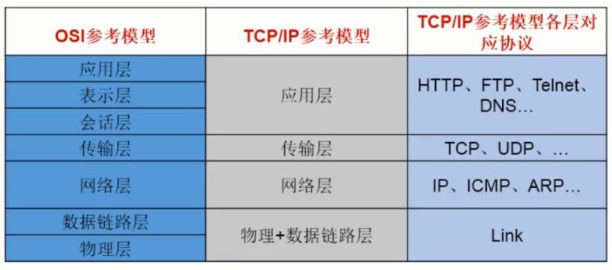Java 是 Internet上的语言,它从语言级上提供了对网络应用程序的支持,程序员能够很容易开发常见的网络应用程序。
Java 提供的网络类库,可以实现无痛的网络连接,联网的底层细节被隐藏在 Java 的本机安装系统里,由 JVM 进行控制。并且 Java 实现了一个跨平台的网络库,程序员面对的是一个统一的网络编程环境。
实现网络中的主机互相通信
1.通信双方地址
IP
端口号
2.一定的规则 (即:网络通信协议。有两套参考模型)
OSI 参考模型: 模型过于理想化,未能在因特网上进行广泛推广
TCP/IP 参考模型(或TCP/IP协议): 事实上的国际标准。
网络通信协议

端口分类
公认端口: 0~1023。被预先定义的服务通信占用(如:HTTP占用端口80,FTP占用端口21,Telnet占用端口23)
注册端口: 1024~49151。分配给用户进程或应用程序。(如:Tomcat占用端口8080,MySQL占用端口3306,Oracle占用端口1521等)。
动态/私有端口:49152~65535。
端口号与IP地址的组合得出一个网络套接字:Socket。
TCP 和 UDP
TCP协议
> 使用TCP协议前,须先建立TCP连接,形成传输数据通道
> 传输前,采用“三次握手”方式,点对点通信,是可靠的
> TCP协议进行通信的两个应用进程:客户端、服务端。
> 在连接中可进行大数据量的传输
> 传输完毕,需释放已建立的连接,效率低
UDP协议
> 将数据、源、目的封装成数据包,不需要建立连接
> 每个数据报的大小限制在64K内
> 发送不管对方是否准备好,接收方收到也不确认,故是不可靠的
> 可以广播发送
> 发送数据结束时无需释放资源,开销小,速度快
TCP
TCPTest1.java
package com.klvchen.java1;
import org.junit.Test;
import java.io.ByteArrayOutputStream;
import java.io.IOException;
import java.io.InputStream;
import java.io.OutputStream;
import java.net.InetAddress;
import java.net.ServerSocket;
import java.net.Socket;
public class TCPTest1 {
//客户端
@Test
public void client(){
Socket socket = null;
OutputStream os = null;
try {
//1.创建Socket对象,指明服务器端的ip和端口号
InetAddress inet = InetAddress.getByName("127.0.0.1");
socket = new Socket(inet, 8899);
//2.获取一个输出流,用于输出数据
os = socket.getOutputStream();
//3. 写出数据的操作
os.write("你好,我是客户端mm".getBytes());
} catch (IOException e) {
e.printStackTrace();
} finally {
//4.资源的关闭
if (os != null) {
try {
os.close();
} catch (IOException e) {
e.printStackTrace();
}
}
if (socket != null) {
try {
socket.close();
} catch (IOException e) {
e.printStackTrace();
}
}
}
}
//服务器
@Test
public void server(){
ServerSocket ss = null;
Socket socket = null;
InputStream is = null;
ByteArrayOutputStream baos = null;
try {
//1.创建服务器端的ServerSocket,指明自己的端口号
ss = new ServerSocket(8899);
//2.调用accept()表示接收来自于客户端的socket
socket = ss.accept();
//3.获取输入流
is = socket.getInputStream();
// 不建议这样写,可能会有乱码
//byte[] buffer = new byte[20];
//int len;
//while ((len = is.read(buffer)) != -1) {
// String str = new String(buffer, 0, len);
// System.out.println(str);
//}
//4.读取输入流中的数据
baos = new ByteArrayOutputStream();
byte[] buffer = new byte[5];
int len;
while ((len = is.read(buffer)) != -1) {
baos.write(buffer, 0 , len);
}
System.out.println(baos.toString());
System.out.println("收到来自于:" + socket.getInetAddress().getHostAddress() + "的数据");
} catch (IOException e) {
e.printStackTrace();
} finally {
//5.关闭资源
if (baos != null) {
try {
baos.close();
} catch (IOException e) {
e.printStackTrace();
}
}
if (is != null) {
try {
is.close();
} catch (IOException e) {
e.printStackTrace();
}
}
if (socket != null) {
try {
socket.close();
} catch (IOException e) {
e.printStackTrace();
}
}
if (ss != null) {
try {
ss.close();
} catch (IOException e) {
e.printStackTrace();
}
}
}
}
}
TCPTest2.java
package com.klvchen.java1;
import org.junit.Test;
import java.io.*;
import java.net.InetAddress;
import java.net.ServerSocket;
import java.net.Socket;
/*
客户端发送文件给服务端,服务端将文件保存在本地
*/
public class TCPTest2 {
@Test
public void client() throws IOException {
Socket socket = new Socket(InetAddress.getByName("127.0.0.1"), 9090);
OutputStream os = socket.getOutputStream();
FileInputStream fis = new FileInputStream(new File("1.png"));
byte[] buffer = new byte[1024];
int len;
while ((len = fis.read(buffer)) != -1) {
os.write(buffer, 0, len);
}
fis.close();
os.close();
socket.close();
}
@Test
public void server() throws IOException{
ServerSocket ss = new ServerSocket(9090);
Socket socket = ss.accept();
InputStream is = socket.getInputStream();
FileOutputStream fos = new FileOutputStream(new File("4.png"));
byte[] buffer = new byte[1024];
int len;
while ((len = is.read(buffer)) != -1) {
fos.write(buffer, 0, len);
}
fos.close();
is.close();
socket.close();
ss.close();
}
}
TCPTest3.java
package com.klvchen.java1;
import org.junit.Test;
import java.io.*;
import java.net.InetAddress;
import java.net.ServerSocket;
import java.net.Socket;
/*
从客户端发送文件给服务端,服务端保存到本地。并返回“发送成功”给客户端。
*/
public class TCPTest3 {
@Test
public void client() throws IOException {
Socket socket = new Socket(InetAddress.getByName("127.0.0.1"), 9090);
OutputStream os = socket.getOutputStream();
FileInputStream fis = new FileInputStream(new File("1.png"));
byte[] buffer = new byte[1024];
int len;
while ((len = fis.read(buffer)) != -1) {
os.write(buffer, 0, len);
}
socket.shutdownOutput();
//接收来自于服务器端的数据,并显示到控制台上
InputStream is = socket.getInputStream();
ByteArrayOutputStream baos = new ByteArrayOutputStream();
byte[] bufferr = new byte[1024];
int len1;
while ((len1 = is.read(bufferr)) != -1) {
baos.write(bufferr,0,len1);
}
System.out.println(baos.toString());
fis.close();
os.close();
socket.close();
baos.close();
is.close();
}
@Test
public void server() throws IOException{
ServerSocket ss = new ServerSocket(9090);
Socket socket = ss.accept();
InputStream is = socket.getInputStream();
FileOutputStream fos = new FileOutputStream(new File("4.png"));
byte[] buffer = new byte[1024];
int len;
while ((len = is.read(buffer)) != -1) {
fos.write(buffer, 0, len);
}
OutputStream os = socket.getOutputStream();
os.write("你好,美女,照片我已收到,非常漂亮!".getBytes());
fos.close();
is.close();
socket.close();
ss.close();
os.close();
}
}